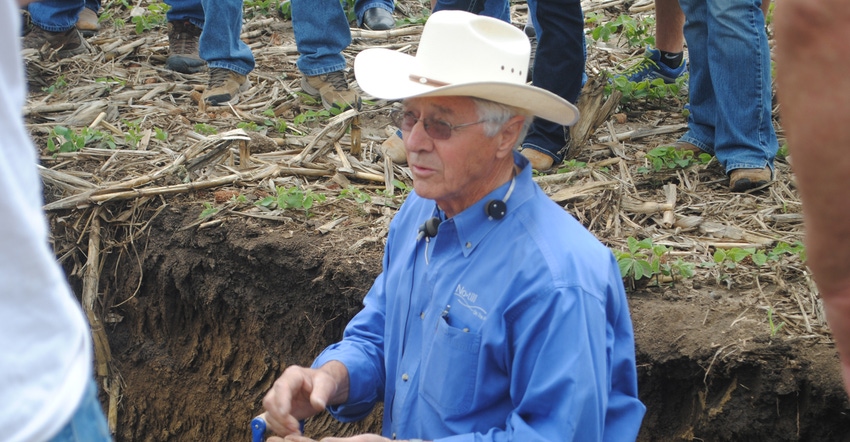
No farmer wants to waste a single ounce of fertilizer this year. With skyrocketing prices and availability concerns, every ounce of nutrients counts. That’s why Nebraska Farmer asked Ray Ward, founder and chairman of the board at Ward Laboratories in Kearney, Neb., to share his knowledge and recommendations about how to get the most out of your nutrient dollars this season.
At the University of Nebraska Testing Ag Performance Solutions program Learn, Launch and Interact kickoff meeting held recently in Kearney, Ward gave a tour of the agriculture testing facilities he founded with his wife, Jolene, in 1983.
Out of their three-bay garage, Ward Laboratories was born, and today it occupies a new and expanded 36,000-square-foot facility of state-of-the-art testing equipment that allows its staff to process a high volume of samples with the highest standards of accuracy.
Quick tips
Here are some quick tips from Ward:
“There are only two ways to apply fertilizer. You do or you don’t.”
“You don’t put more diesel in the tank when the gauge says it is full. The same goes with fertilizer needs. If the tank [soil] is full, do not add any more. This is the importance of soil testing.”
"Stick with the basic fertilizers. No need for the fancy stuff.”
Giving credit
“Residual nitrogen is a very important soil test to have to help reduce N application,” Ward says. “The average N reported for corn is 0.67 pounds of N per bushel of corn. So, the goal should be to get as close to that value as possible. This is a lot easier when following soybeans, because we give credit of 40 pounds of N for the past soybean crop.”
Ward believes you could use 1 pound of N per bushel of soybeans up to 60 bushels per acre as an N credit for the following corn crop.
“Residual N is very important to use to make sure you do not overdo the N application,” he says. “On our farm in Saline County, we applied 135 pounds of N per acre and got a yield of 73 bushels per acre because of a lack of rain. We had up to 200 pounds of N left over in this field, so I would say we will not get any response this year.
“Another example is from the Bertrand, Neb., area where in the fall of 2012 — after a year of extreme drought — we had enough residual nitrate to make a ‘zero’ N recommendation for 240 bushels-per-acre corn yield for 2013. In the fall of 2013, we could see if the farmer reduced their N rate after 2012. Some farmers had low carryover nitrate, and others still had high nitrate carryover. Cost is a consideration with N application, but corn does not care about the cost of N. If you reduce the N application rate, you may reduce yield. But then it all comes down to good marketing.”
To sample for residual N, Ward encourages sampling the top 8 inches of soil separately from the subsoil of 8 to 36 inches. “Some go 8 to 24 inches of subsoil,” he says. “If we do not get a subsoil, we assume 25 pounds of nitrate N in the subsoil. At times, we see very large carryover nitrate depending on yield, rate of N that was applied and soil health. More microbial activity indicates more N available for crops, and nitrate in the root zone is N that is available for the next crop.”
Boost microbes
So how do we boost microbial activity? Ward says there are two things to remember. “Apply a modest rate of manure or compost and plant cover crops,” he says. “Plant roots leak out organic compounds — that is the best food source for microbes. They can survive about 30 days without food. The food is mainly the exudate that the plant root leaks out.”
Cover crops, especially when they are used for animal grazing, also boost microbes in the soil. “Planting cover crops, I think, is the best way to increase soil aggregates,” Ward says. “These granules make the soil more porous, so water gets in the soil faster and aggregates help retain moisture.”
If the soil is covered by crop residue to protect the soil from the impact of raindrops, then aggregate stability really increases, Ward says.
“We are developing a ‘soil health assessment’ test package that will include the water stable aggregate test,” he says. “This is a very important soil physical component. The biological components are CO2-C respiration and water extractable organic carbon and organic N tests. The chemical components are the plant nutrients.”
Manure matters
With high fertilizer costs, farmers are looking more and more to manure for fertility. “We have a standard manure test that includes nitrate, ammonium, organic N, total N, phosphorus, potassium, calcium, magnesium, sulfur, zinc, iron, manganese and copper,” Ward says. “Moisture, pH and EC or soluble salts are also included in the report.”
Ward likes to see a low amount of N go on with manure early to get corn off to a good start. “As soil warms, then the N in the manure will decompose, supplying N for the corn,” he says.
“Some feedlot manure is very high in nutrient content,” Ward explains. “If wet distillers grain is fed, then the manure is higher in phosphorus.”
Dairy manure, Ward says, has less nutrients because more of the nutrients go away from the barnyard because of the nutrient content of the milk. “Poultry manure is much higher in available N than cattle manure,” he says. “Lagoon manure is extremely variable, depending on what the animals are being fed.”
Producers who spread manure every year need to be mindful especially of phosphorus content because of its high concentrations in the manure, Ward adds.
Spoon-feeding a crop, with a split application of fertilizer throughout the growing season greatly improves the efficiency of nutrient application, Ward says. “You are feeding the crop as it needs the nutrient, so efficiency improves,” he says. “When someone says to me that ‘we just lost the nutrient,’ I wonder how can someone say it is OK to lose N, for example, and not worry about where it was lost to. I see too many water samples that have that N, and it is not acceptable.”
Ward believes that farms do a good job of applying N most years. “I do not see high residual nitrate most of the time,” he says. “With phosphorus, I have seen some operations increase in P soil tests and they can cut back, and other operations that should be using more. We are seeing lower sulfur readings and see many farmers using more sulfur. I think sulfur helps to make N more efficient.”
Fields that have been adequate in zinc for many years may now need more zinc, he says. “I see manganese getting low and hear that some farmers are using more manganese. We have areas in Nebraska where boron is low and needs to be applied. Now we are starting to look at molybdenum, cobalt, nickel and silica, but I do not get excited about these, although there are always folks who are interested.”
Learn more about soil testing and Ray Ward at wardlab.com.
About the Author(s)
You May Also Like






